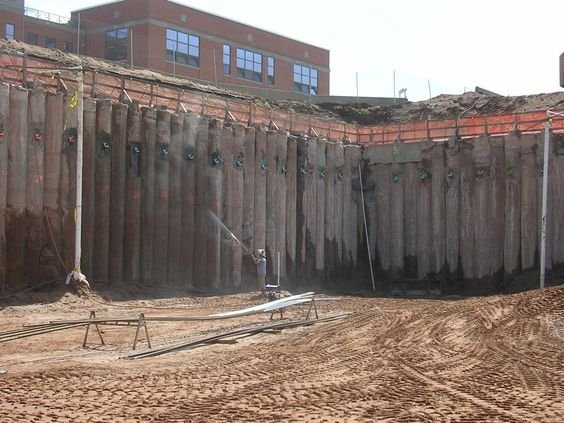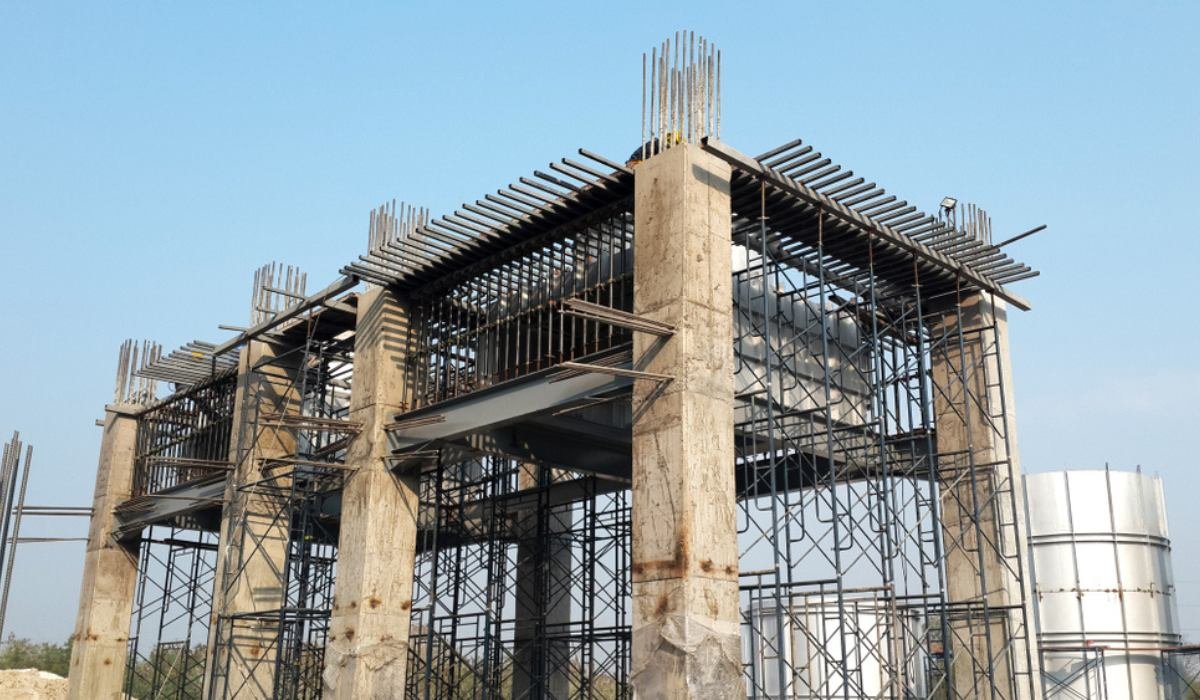It is essential for construction experts to make use of a variety of shoring methods while they are working on excavations or building sites to avoid a facility from toppling. The use of shoring may aid professionals in complying with safety standards and preventing accidents during excavation and building. In the following paragraphs, we will define the term “shoring” and then provide a rundown of the different forms of shoring that may be used for construction activities.
see also: all about underpinning meaning
Shoring: What is it?
The term “shoring” refers to the technique of constructing a temporary framework to sustain an unsound structure at construction and digging sites. Specialists use shoring while repairing broken or damaged walls or foundations, demolishing buildings, altering existing walls, building new walls, or doing any of these other tasks.
Shoring: Why is it important?
As the demand for urban space has increased over the last several years and architects have been pushing the bounds of construction in order to expand closer to property limits, there has been an increased need for more modern shoring methods. Nevertheless, even in its simplest form, shoring fulfils a variety of important roles at a construction site. Among its numerous advantages are the following:
Enhanced safety
Excavation is a necessary step in the building process for both basements and foundations. Shoring is required in order to protect the employees who are temporarily working in trenches and holes. A safer working environment is maintained by maintaining the height of the earthen walls and avoiding their collapse.
Expedited scheduling
Repeatedly digging out a site may be expensive and cause major delays, which can derail a contractor’s timeline. Members of the team who aren’t worried about their own safety are better able to focus on the task at hand, which reduces the likelihood of mistakes that waste time.
Lower costs
When builders don’t have to worry about the prospect of excavations collapsing, it’s considerably simpler for them to stick to their budgets.
Shoring: Types
When determining which form of shoring to employ, specialists take a number of factors into account, including the site’s soil, its closeness to existing buildings, and its environment. The following is a list of the several types of shoring that are used by building professionals:
H and I-beam shoring

Source: Pinterest
Shoring made from H and I-beams, often called soldier pile walls, is used to support excavation projects between 50 and 200 inches deep. H and I-beam shoring may be installed either by penetrating into the ground and then integrating precast steel beams or by embedding the steel beams directly into the earth without drilling. After the steel beams have been embedded in the ground, the shoring wall is constructed by inserting concrete blocks in between the beams.
Secant pile shoring

Source: Pinterest
When constructing a shoring system using secant piles, two separate walls are brought together at right angles to one another. The stronger wall is called the main wall, while the weaker one is called the secondary wall in the jargon of the construction industry. Construction crews resort to this kind of shoring when extensive excavation is not an option, usually due to the proximity of adjacent buildings. The secant pile shoring technique requires extra caution during construction since it is often used in close proximity to an existing structure.
Contiguous pile shoring

Source: swissboring.com
This type of shoring, often referred to as tangent pile shoring, is effective in areas where there is either low water pressure or a lack of water on the building site. Contiguous pile shoring is characterised by lengthy, closely-spaced rows of piles, which are concrete cylinders. This kind of shoring may be used to protect valuables from water damage.
Sheet piles

Source: Pinterest
For the purpose of fabricating sheet piles, experts often use vibratory hammers, which employ vertical vibrations to sever steel. The hammer is pounded into the earth via the foundation’s prefabricated steel piers. The sheet piles are joined together to create the shoring wall. Sheet piles are used by experts to prevent dirt from washing away during soil excavations and are also a good option for excavations near water.
Diaphragm walls

Source: designingbuildings.co.uk
This is a special sort of shoring used by professionals when conventional shoring methods are insufficient for a certain excavation depth. Although diaphragm walls are the strongest and stay the longest of the shoring kinds, they are also the most difficult to remove after excavation is complete. Building tunnels or underground rooms with diaphragm walls is a viable alternative.
Raking shoring

Source: Pinterest
Experts use rake shoring types, which consist of wood beams placed against the building to be supported and then dug into the earth. Beams, or rakers, are used to provide structural support and are typically set at an inclination of 60° to 70°. Steel wall plates may be installed by professionals to reinforce the building and make sure each of the rakers stays firm.
Hydraulic shoring

Source: Pinterest
Specialists use hydraulic shoring when they need to complete an excavation operation rapidly since it is both quicker and easier than other types of shoring. In general, they employ different shoring techniques for lengthier excavation works, although hydraulic shoring is great for shorter excavations because the machinery used is simpler to operate.
A hydraulic piston is a cylinder through which water is forced at high pressure in order to operate hydraulic shoring. The hydraulic pistons are pushed outward until they hit the necessary walls. Steel plates are often placed against the walls by experts as a focus for the pistons.
Soil nail shoring

Source: Pinterest
The installation of reinforcing materials, such as steel bars or nails, helps to fortify sloped soil and walls when using the soil nail shoring technique. Following the drilling of a hole in the ground by trained professionals, the reinforcement material is positioned adjacent to the weakened structure. They set the material such that it slopes downhill in order to provide a higher level of stability and improved coverage against any natural hazards, such as wind.
Timber shoring

Source: Pinterest
It is used by experts for a wide range of purposes, including when alternative shoring materials are unavailable or when access to an excavation site is limited. Wooden shoring is the practice of using timber to shore up horizontal constructions in trenches. Professionals may use the materials to squeeze through tight places and reach previously inaccessible areas of trenches.
Dead shoring

Source: Pinterest
Dead shoring is used by experts to bear a building’s dead load. It requires additional support structures, such as steel plates, to be attached to vertical beams. Usually, the dead weight is supported by a connection between two beams with a third beam resting over them. Because dead shoring can support a lot of weight while yet preserving the remaining portions of a damaged structure, it is often the shoring of choice when the majority of the building being worked on has sustained considerable damage. To further fortify the structure’s underpinning, beams are often included in the design.
Flying shoring
The term “flying shoring” refers to a method used by professionals to prevent the breakdown of two parallel walls. Steel plates, beams, columns, and staining components are used in the construction of flying shoring. Experts will need to construct scaffolding that will fit between the walls to prevent them from collapsing.
Pneumatic shoring

Source: mswmag.com
Pneumatic shoring is the practice of employing air pressure from air compressors to support buildings. The air compressor takes either electric or gasoline power and changes it into the energy needed to pressurise air, which may then be used as a high-pressure force to support buildings.
Shoring: What determines the shoring type to be used?
In each given circumstance, the kind of shoring that is necessary will be decided based on a number of different considerations.
- The load that the building components carry.
- The total load that must be sustained by the structural components.
- The current structure’s typical load capability.
- The supporting structure’s condition.
- Shoring stability is based on foundation condition and floor/surface angle.
- Supply of necessary shoring materials.
- Instability in both the horizontal and vertical planes.
Building with Shoring: Supporting deep excavations
Usually, the parking needs in high-rise buildings are met by the basement floors. The construction of a basement structure involves planning the cost of deep excavation. Shoring becomes crucial in retaining the earth, ground water and adjacent structure, thus ensuring efficient excavation and construction.
It requires two important component of shoring system:
- Earth retention system (piles or wall)
- Support system (internal/ external bracing like rakers, structs and tiebacks)
FAQs
What use does construction shoring serve?
When a building's walls are swelling out or cracking as a result of unequal settling of the foundation, shorings are employed to stabilise the structure. It's also employed when demolishing a neighbouring building or expanding an existing opening in a wall.
Where in the building is shoring used?
In construction, shoring is the traditional method for supporting subterranean excavation. It's also employed as a stopgap measure until more permanent reinforcements or renovations are made to the above-ground buildings.
Are shorings permanent?
The shoring walls might be temporary, or they could be permanent. Once the soil has been effectively held, permanent shoring treatments are often augmented with concrete walls.
What depth is shoring required?
In most cases, a shoring system is required for excavations that are at least 1.2 metres (about 4 feet) deep. The only exception to this rule is when the excavation is performed completely in stable rock.
What is building formwork?
The mould used to shape concrete into the various shells, slabs, columns, and beams that make up a building is called formwork. There are a variety of materials that may be used, including plastic, steel, wood, and fibreglass. To prevent the concrete from adhering to the formwork, a bond breaker is applied to the interior.
Housing News Desk is the news desk of leading online real estate portal, Housing.com. Housing News Desk focuses on a variety of topics such as real estate laws, taxes, current news, property trends, home loans, rentals, décor, green homes, home improvement, etc. The main objective of the news desk, is to cover the real estate sector from the perspective of providing information that is useful to the end-user.
Facebook: https://www.facebook.com/housing.com/
Twitter: https://twitter.com/Housing
Email: editor@housing.com











